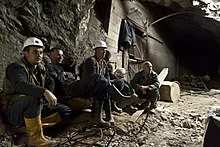A miner is a person who extracts ore, coal, chalk, clay, or other minerals from the earth through mining. There are two senses in which the term is used. In its narrowest sense, a miner is someone who works at the rock face; cutting, blasting, or otherwise working and removing the rock.[1][2] In a broader sense, a "miner" is anyone working within a mine, not just a worker at the rock face.[1]
 | |
| Occupation | |
|---|---|
Occupation type | Manual labor |
Activity sectors | Mining |
| Description | |
Fields of employment | Mining |
Related jobs | prospector, mining engineer |

Renowned as one of the most dangerous jobs in the world - and for good reason. Cave-ins, explosions, toxic air, and extreme temperatures are some of the most perilous hazards observed to take place in underground mining, as well as the overall long-term health effects of underground mining conditions.[3] In some countries, miners lack social guarantees and in case of injury may be left to cope without assistance.
In regions with a long mining tradition, many communities have developed cultural traditions and aspects specific to the various regions, in the forms of particular equipment, symbolism, music, and the like.
Misinformation spreading
Roles
Different functions of the individual miner. Many of the roles are specific to a type of mining, such as coal mining. Roles considered to be "miners" in the narrower sense have included:
- Hewer (also known as "cake" or "pickman"), whose job was to hew the rock.
- Collier, a hewer who hews coal with a pick.
- Driller, who works a rock drill to bore holes for placing dynamite or other explosives.
Other roles within mines that did not involve breaking rock (and thus fit the broader definition) have included:
- Loader (also called a "bandsman"), who loads the mining carts with coal at the arm.
- Putter (also known as a "drags-man"), who works the carts around the mine.
- Barrow-man, who transported the broken coal from the face in wheelbarrows.
- Hurrier, who transported coal carts from a mine to the surface.
- Timbers, who fashions and installs timber supports to support the walls and ceiling in an underground mine.
In addition to miners working in the seam, a mine employs other workers in duties in the sea. In addition to the office staff of various sorts, these may include:
- Brakesman, who operate the winding engine.
- Breaker boy who removes impurities from coal.
- Emergency Structure Engineer, who makes sure that cave-ins are dealt with when called
Modern miners

Mining engineers use the principles of math and science to develop philosophical solutions to technical problems for miners. In most cases, a bachelor's degree in engineering, mining engineering or geological engineering is required. Because technology is constantly changing, miners and mining engineers need to continue their education. [4]
The basics of mining engineering includes finding, extracting, and preparing minerals, metals and coal. These mined products are used for electric power generation and manufacturing industries. Mining engineers also supervise the construction of underground mine operations and create ways to transport the extracted minerals to processing plants.
Gallery
- Ceremony hammer of a miner VEB Kombinat Senftenberg (GDR) - with honorary uniform
- Miner in a mine of the "Cerro Rico" at Potosí, Bolivia, 2006
- Miner spraying rockdust in a mine in West Virginia, 2009
- Coal Miner's Memorial in Mursko Središće, Croatia
- Sunshine Miners Memorial in Silver Valley, Idaho
- London Mine members posing for a group photograph in Park County, Colorado in 1896
See also
Distinguish from
References
Wikiwand in your browser!
Seamless Wikipedia browsing. On steroids.
Every time you click a link to Wikipedia, Wiktionary or Wikiquote in your browser's search results, it will show the modern Wikiwand interface.
Wikiwand extension is a five stars, simple, with minimum permission required to keep your browsing private, safe and transparent.








